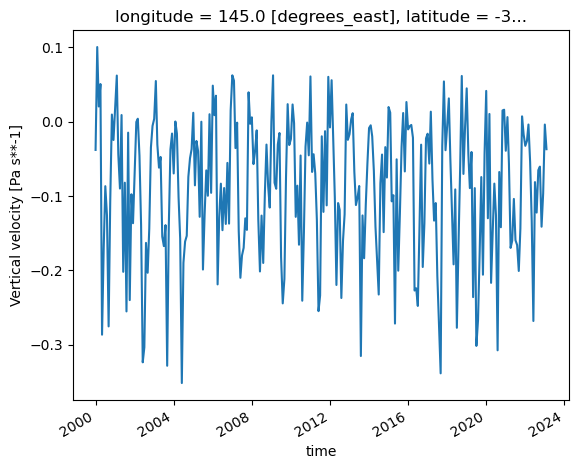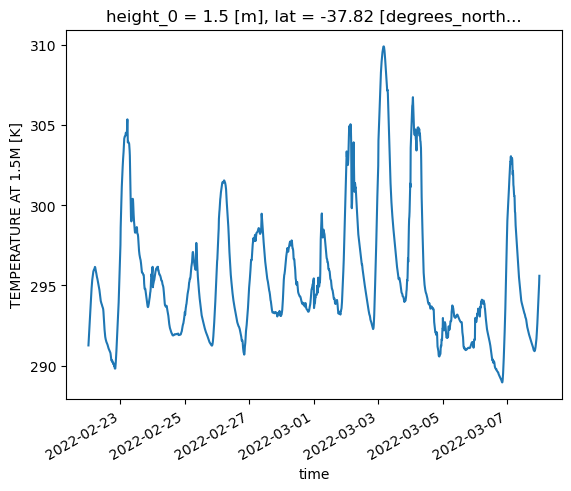More efficent use of xarray.open_mfdataset()#
A common workflow associated with data analysis using xarray is a “chain”-type workflow, where one operation leads to another, then to another, and so on, until the final result is produced. Each operation produces a DataSet or DataArray that is a step closer to the final result.
Most workflows of this type have a ‘correct’ order of operations that will minimise the amount of computation done on the dataset. Running the workflow in the ‘wrong’ order won’t necessarily fail, it may just take longer. Whilst this isn’t an issue with smaller datasets, when analysing the datasets produced large models like AUS2200, running these operations out-of-order can often result in hangs or crashes.
xarray often works like this internally as well. A single xarray operation can include a chain of smaller operations that produce the desired result. xarray.open_mfdataset() is one of these operations, internally consisting of a series of xarray.open_dataset() operations followed by an xarray.concat(). These operations can be parallelised over a dask cluster by passing parallel=True to open_mfdataset().
A standard wokflow using open_mfdataset() might look like the following:
import xarray as xr
import glob
import dask
import logging
from dask.distributed import Client
client = Client(threads_per_worker=1,memory_limit=0,silence_logs=logging.ERROR)
client
Client
Client-81103a85-117b-11ee-9731-00000084fe80
| Connection method: Cluster object | Cluster type: distributed.LocalCluster |
| Dashboard: /proxy/8787/status |
Cluster Info
LocalCluster
9a0a721c
| Dashboard: /proxy/8787/status | Workers: 4 |
| Total threads: 4 | Total memory: 0 B |
| Status: running | Using processes: True |
Scheduler Info
Scheduler
Scheduler-e4c1f7d6-1180-43d6-9f47-1ee92a87901a
| Comm: tcp://127.0.0.1:35797 | Workers: 4 |
| Dashboard: /proxy/8787/status | Total threads: 4 |
| Started: Just now | Total memory: 0 B |
Workers
Worker: 0
| Comm: tcp://127.0.0.1:37883 | Total threads: 1 |
| Dashboard: /proxy/33671/status | Memory: 0 B |
| Nanny: tcp://127.0.0.1:37335 | |
| Local directory: /jobfs/88765053.gadi-pbs/dask-scratch-space/worker-bwdk_rwc | |
Worker: 1
| Comm: tcp://127.0.0.1:46247 | Total threads: 1 |
| Dashboard: /proxy/33189/status | Memory: 0 B |
| Nanny: tcp://127.0.0.1:39157 | |
| Local directory: /jobfs/88765053.gadi-pbs/dask-scratch-space/worker-uwgzta6w | |
Worker: 2
| Comm: tcp://127.0.0.1:43269 | Total threads: 1 |
| Dashboard: /proxy/39417/status | Memory: 0 B |
| Nanny: tcp://127.0.0.1:36467 | |
| Local directory: /jobfs/88765053.gadi-pbs/dask-scratch-space/worker-suf370ot | |
Worker: 3
| Comm: tcp://127.0.0.1:42635 | Total threads: 1 |
| Dashboard: /proxy/43755/status | Memory: 0 B |
| Nanny: tcp://127.0.0.1:35937 | |
| Local directory: /jobfs/88765053.gadi-pbs/dask-scratch-space/worker-_yp9kdcz | |
era5_vert_winds_files=sorted(glob.glob('/g/data/rt52/era5/pressure-levels/monthly-averaged/w/20*/*.nc'))
ds=xr.open_mfdataset(era5_vert_winds_files,parallel=True)
ds
<xarray.Dataset>
Dimensions: (longitude: 1440, latitude: 721, level: 37, time: 278)
Coordinates:
* longitude (longitude) float32 -180.0 -179.8 -179.5 ... 179.2 179.5 179.8
* latitude (latitude) float32 90.0 89.75 89.5 89.25 ... -89.5 -89.75 -90.0
* level (level) int32 1 2 3 5 7 10 20 30 ... 850 875 900 925 950 975 1000
* time (time) datetime64[ns] 2000-01-01 2000-02-01 ... 2023-02-01
Data variables:
w (time, level, latitude, longitude) float32 dask.array<chunksize=(1, 37, 721, 1440), meta=np.ndarray>
Attributes:
Conventions: CF-1.6
license: Licence to use Copernicus Products: https://apps.ecmwf.int/...
summary: ERA5 is the fifth generation ECMWF atmospheric reanalysis o...
title: ERA5 pressure-levels monthly-averaged vertical_velocity 200...
history: 2020-11-06 00:34:01 UTC+1100 by era5_replication_tools-1.5....### Pick out the 850hPa pressure level
ds_850=ds.sel(level=850)
### Pick out the grid point corresponding to Melbourne
ds_850_mel=ds_850.sel(latitude=-37.81, longitude=144.96, method='nearest')
ds_850_mel['w'].plot()
[<matplotlib.lines.Line2D at 0x14e042141b20>]

Now, this is a fairly contrived example, but it does highlight the idea behind the ‘chain’ workflow. The dataset files are opened, then concatenated, then a pressure level is picked out, followed by a single point. mf_dataset takes an argument, preprocess, that can change the order of operations within the workflow and arrive at the same result.
def _preprocess(ds):
return ds.sel(level=850,latitude=-37.81, longitude=144.96, method='nearest')
era5_vert_winds_files=glob.glob('/g/data/rt52/era5/pressure-levels/monthly-averaged/w/20*/*.nc')
ds_850_mel=xr.open_mfdataset(era5_vert_winds_files,parallel=True,preprocess=_preprocess)
ds_850_mel
<xarray.Dataset>
Dimensions: (time: 278)
Coordinates:
longitude float32 145.0
latitude float32 -37.75
level int32 850
* time (time) datetime64[ns] 2000-01-01 2000-02-01 ... 2023-02-01
Data variables:
w (time) float32 dask.array<chunksize=(1,), meta=np.ndarray>
Attributes:
Conventions: CF-1.6
license: Licence to use Copernicus Products: https://apps.ecmwf.int/...
summary: ERA5 is the fifth generation ECMWF atmospheric reanalysis o...
title: ERA5 pressure-levels monthly-averaged vertical_velocity 200...
history: 2020-11-06 00:34:01 UTC+1100 by era5_replication_tools-1.5....ds_850_mel['w'].plot()
[<matplotlib.lines.Line2D at 0x14df929ccf40>]

The preprocess argument to mf_dataset takes a function that takes a single xarray DataSet as its argument, and can return either a DataSet or DataArray. The function given as the preprocess argument will then operate on every dataset from each file passed to open_mfdataset before the concatenation occurs. In this example, it’s more efficient to perform the sel after open_mfdataset, however that isn’t always the case.
AUS2200 model output data#
The raw output from the AUS2200 model is directly converted to netCDF from the UM Fields File format, and as such, contains many different fields in the same file. Often, the same file can contain fields with different grid types and different time scales. As a 2.2km atmosphere model, the size of these datasets is also rather large. A single hourly output file weighs in at around 8GB of compressed netCDF, so constructing time-series data can involve reading over multiple TB of files. For this example, we’ll plot surface temperature of a single point in a 2-week model run at 10 minute intervals from hourly files. This involves reading from 336 files, each containing 39 variables, with 2 different grid projections, 2 different time scales and a pseudo level coordinate that is only applied to 3 fields.
%%time
ds=xr.open_dataset('/g/data/hh5/tmp/WACI-Hackathon-2023/AUS2200/flood22-barra-soil-24hspinup/atmos/umnsa_spec_20220222T0000_10min.nc')
ds.fld_s00i024
CPU times: user 1.55 s, sys: 199 ms, total: 1.75 s
Wall time: 2.01 s
<xarray.DataArray 'fld_s00i024' (time: 6, lat: 2120, lon: 2600)>
[33072000 values with dtype=float32]
Coordinates:
* time (time) datetime64[ns] 2022-02-22T00:10:00 ... 2...
* lat (lat) float64 -48.79 -48.77 ... -6.852 -6.832
* lon (lon) float64 107.5 107.5 107.6 ... 159.0 159.0
theta_level_height float64 ...
model_theta_level_number int32 ...
sigma_theta float64 ...
height float64 ...
height_0 float64 ...
Attributes:
standard_name: surface_temperature
long_name: SURFACE TEMPERATURE AFTER TIMESTEP
units: K
um_stash_source: m01s00i024
grid_mapping: latitude_longitude%%time
aus2200_file_list=sorted(glob.glob('/g/data/hh5/tmp/WACI-Hackathon-2023/AUS2200/flood22-barra/atmos/umnsa_spec_*.nc'))
### Need this to prevent many warning messages
with dask.config.set(**{'array.slicing.split_large_chunks':False}):
ds=xr.open_mfdataset(aus2200_file_list,chunks={'time': 6, 'time_0':6, 'lat':414, 'lon':520},parallel=True,combine="nested",concat_dim=["time"])
ds
CPU times: user 1min 41s, sys: 10.1 s, total: 1min 51s
Wall time: 2min 17s
<xarray.Dataset>
Dimensions: (lat: 2120, lon: 2600, pseudo_level: 5,
lon_0: 2600, lat_0: 2121, time_0: 2304,
time: 2304, bnds: 2)
Coordinates:
* lat (lat) float64 -48.79 -48.77 ... -6.852 -6.832
* lon (lon) float64 107.5 107.5 107.6 ... 159.0 159.0
* pseudo_level (pseudo_level) int32 1 2 3 4 5
* lon_0 (lon_0) float64 107.5 107.5 107.5 ... 159.0 159.0
* lat_0 (lat_0) float64 -48.8 -48.78 ... -6.842 -6.822
* time_0 (time_0) datetime64[ns] 2022-02-19T12:05:00 ......
* time (time) datetime64[ns] 2022-02-19T12:10:00 ... 2...
theta_level_height float64 5.0
model_theta_level_number int32 1
sigma_theta float64 0.9994
height float64 10.0
height_0 float64 1.5
Dimensions without coordinates: bnds
Data variables: (12/39)
fld_s00i010 (time, lat, lon) float32 dask.array<chunksize=(6, 414, 520), meta=np.ndarray>
latitude_longitude (time) int32 -2147483647 ... -2147483647
lat_bnds (time, lat, bnds) float64 dask.array<chunksize=(6, 414, 2), meta=np.ndarray>
lon_bnds (time, lon, bnds) float64 dask.array<chunksize=(6, 520, 2), meta=np.ndarray>
theta_level_height_bnds (time, bnds) float64 dask.array<chunksize=(6, 2), meta=np.ndarray>
sigma_theta_bnds (time, bnds) float64 dask.array<chunksize=(6, 2), meta=np.ndarray>
... ...
fld_s21i101 (time, lat, lon) float64 dask.array<chunksize=(6, 414, 520), meta=np.ndarray>
fld_s21i104 (time, time_0, lat, lon) float32 dask.array<chunksize=(6, 2304, 414, 520), meta=np.ndarray>
fld_s30i403 (time, lat, lon) float32 dask.array<chunksize=(6, 414, 520), meta=np.ndarray>
fld_s30i404 (time, lat, lon) float32 dask.array<chunksize=(6, 414, 520), meta=np.ndarray>
fld_s30i405 (time, lat, lon) float32 dask.array<chunksize=(6, 414, 520), meta=np.ndarray>
fld_s30i406 (time, lat, lon) float32 dask.array<chunksize=(6, 414, 520), meta=np.ndarray>
Attributes:
history: File /scratch/ly62/dr4292/cylc-run/u-cs142-barra/share/cycl...
Conventions: CF-1.6
source: Data from Met Office Unified Model
um_version: 12.2%%time
da_surface_temp_melb=ds['fld_s00i024'].sel(lat=-37.81, lon=144.96, method='nearest')
da_surface_temp_melb.plot()
CPU times: user 3.29 s, sys: 428 ms, total: 3.71 s
Wall time: 20.4 s
[<matplotlib.lines.Line2D at 0x14df7404e640>]

Note that it takes quite a bit of careful tuning and options passed to open_mfdataset to get a sensible DataSet out at all. Just running open_mfdataset with none of these settings takes twice as long, results in several thousand lines of warning messages about large chunks, and fails to handle the two overlapping time dimensions in the files correctly, resulting in every variable being defined over both time dimensions. That’s all before the surface temperature plot is created. The timings in this notebook are based on a ‘medium’ sized job on the normal queue. When I ran the workflow with the unoptimised open_mfdataset call on an ‘xxxlarge’ sized job in the normalsr queue, it crashed before creating the average temperature plot due to exceeding the node’s memory limit of 496GB.
I spent about half a day coming up with the tuning settings used in open_mfdataset. These settings are not generic either, a different dataset will required different parameters to be opened correctly. In fact, different variables within the AUS2200 dataset will require different settings.
All of this can be avoided by writing a one line function and using preprocess to pick out the surface temperature dataset from the beginning.
### Free up memory
del(ds)
%%time
def _preprocess(ds):
return ds['fld_s00i024']
ds_preprocess=xr.open_mfdataset(aus2200_file_list,preprocess=_preprocess,parallel=True)
ds_preprocess
CPU times: user 59.9 s, sys: 4.24 s, total: 1min 4s
Wall time: 1min 8s
<xarray.Dataset>
Dimensions: (time: 2304, lat: 2120, lon: 2600)
Coordinates:
* time (time) datetime64[ns] 2022-02-19T12:10:00 ... 2...
* lat (lat) float64 -48.79 -48.77 ... -6.852 -6.832
* lon (lon) float64 107.5 107.5 107.6 ... 159.0 159.0
theta_level_height float64 5.0
model_theta_level_number int32 1
sigma_theta float64 0.9994
height float64 10.0
height_0 float64 1.5
Data variables:
fld_s00i024 (time, lat, lon) float32 dask.array<chunksize=(6, 2120, 2600), meta=np.ndarray>%%time
ds_preprocess['fld_s00i024'].sel(lat=-37.81, lon=144.96, method='nearest').plot()
CPU times: user 2.94 s, sys: 382 ms, total: 3.32 s
Wall time: 18.8 s
[<matplotlib.lines.Line2D at 0x14df74176c10>]

Other uses of preprocess#
preprocess can also be used to perform operations on datasets with inconsistencies, such as axes or units. Take for example the following hypothetical scenario. An experiment has been run and single variable files have been created. The experiment was recently extended, and single variable files are not yet available, but a time-series needs to be produced over the full extended timeframe. The single variable dataset looks as follows:
postprocessed_file_list=sorted(glob.glob("/g/data/hh5/tmp/WACI-Hackathon-2023/AUS2200/flood22-barra/tas_10min_202202*.nc"))
ds_single_var=xr.open_mfdataset(postprocessed_file_list,parallel=True)
ds_single_var
<xarray.Dataset>
Dimensions: (time: 1008, lat: 2120, lon: 2600, bnds: 2)
Coordinates:
height_0 float64 1.5
* lat (lat) float64 -48.79 -48.77 -48.75 ... -6.852 -6.832
* lon (lon) float64 107.5 107.5 107.6 ... 158.9 159.0 159.0
* time (time) datetime64[ns] 2022-02-22T00:10:00 ... 2022-03-01
Dimensions without coordinates: bnds
Data variables:
tas (time, lat, lon) float32 dask.array<chunksize=(144, 2120, 2600), meta=np.ndarray>
lat_bnds (time, lat, bnds) float64 dask.array<chunksize=(144, 2120, 2), meta=np.ndarray>
latitude_longitude (time) int32 -2147483647 -2147483647 ... -2147483647
lon_bnds (time, lon, bnds) float64 dask.array<chunksize=(144, 2600, 2), meta=np.ndarray>
Attributes:
Conventions: CF-1.6
source: Data from Met Office Unified Model
um_version: 12.2
NCO: netCDF Operators version 5.0.5 (Homepage = http://nco.sf.ne...And the raw dataset looks like this:
def _preprocess(ds):
return ds['fld_s00i024']
raw_file_list=sorted(glob.glob("/g/data/hh5/tmp/WACI-Hackathon-2023/AUS2200/flood22-barra/atmos/umnsa_spec_202203*.nc"))
ds_raw=xr.open_mfdataset(raw_file_list,parallel=True,preprocess=_preprocess)
ds_raw
<xarray.Dataset>
Dimensions: (time: 1008, lat: 2120, lon: 2600)
Coordinates:
* time (time) datetime64[ns] 2022-03-01T00:10:00 ... 2...
* lat (lat) float64 -48.79 -48.77 ... -6.852 -6.832
* lon (lon) float64 107.5 107.5 107.6 ... 159.0 159.0
theta_level_height float64 5.0
model_theta_level_number int32 1
sigma_theta float64 0.9994
height float64 10.0
height_0 float64 1.5
Data variables:
fld_s00i024 (time, lat, lon) float32 dask.array<chunksize=(6, 2120, 2600), meta=np.ndarray>def _combined_preprocess(ds):
if "fld_s00i024" in ds:
da=ds['fld_s00i024']
da=da.drop(['theta_level_height','sigma_theta',"model_theta_level_number","height"])
return da.rename("tas")
return ds["tas"]
ds_combined=xr.open_mfdataset(postprocessed_file_list+raw_file_list,parallel=True,preprocess=_combined_preprocess,chunks={'time': 6})
ds_combined
<xarray.Dataset>
Dimensions: (lat: 2120, lon: 2600, time: 2016)
Coordinates:
height_0 float64 1.5
* lat (lat) float64 -48.79 -48.77 -48.75 -48.73 ... -6.871 -6.852 -6.832
* lon (lon) float64 107.5 107.5 107.6 107.6 ... 158.9 158.9 159.0 159.0
* time (time) datetime64[ns] 2022-02-22T00:10:00 ... 2022-03-08
Data variables:
tas (time, lat, lon) float32 dask.array<chunksize=(6, 2120, 2600), meta=np.ndarray>In this example, we’ve used preprocess to essentially post-process the raw data on the fly, renaming the UM field (fld_s00i024) to match the name of the post-processed field (tas), and dropping the coordinates not related to the surface temperature field. We now have a single contiguous dataset from two very different sources.
ds_combined["tas"].sel(lat=-37.81, lon=144.96, method='nearest').plot()
[<matplotlib.lines.Line2D at 0x14df7f1f9310>]

Summary#
The preprocess argument to open_mfdataset provides good opportunities to optimise access to large datasets. Rather than spending time tuning chunk sizes and dask options, it may be possible to change the order of operations with the preprocess argument to just have the variable you need concatenated. We have also demonstrated how preprocess can be used to pull together inconsistent datasets in order to allow open_mfdataset to work at all.
Like any xarray tuning settings, there is no silver bullet that will always improve performance. For smaller datasets, preprocess may actually increase runtime due to the overhead of having to run what ends up being very small operations multiple times. preprocess is another tool, like chunking, that can be used to improve data analysis workflows.
